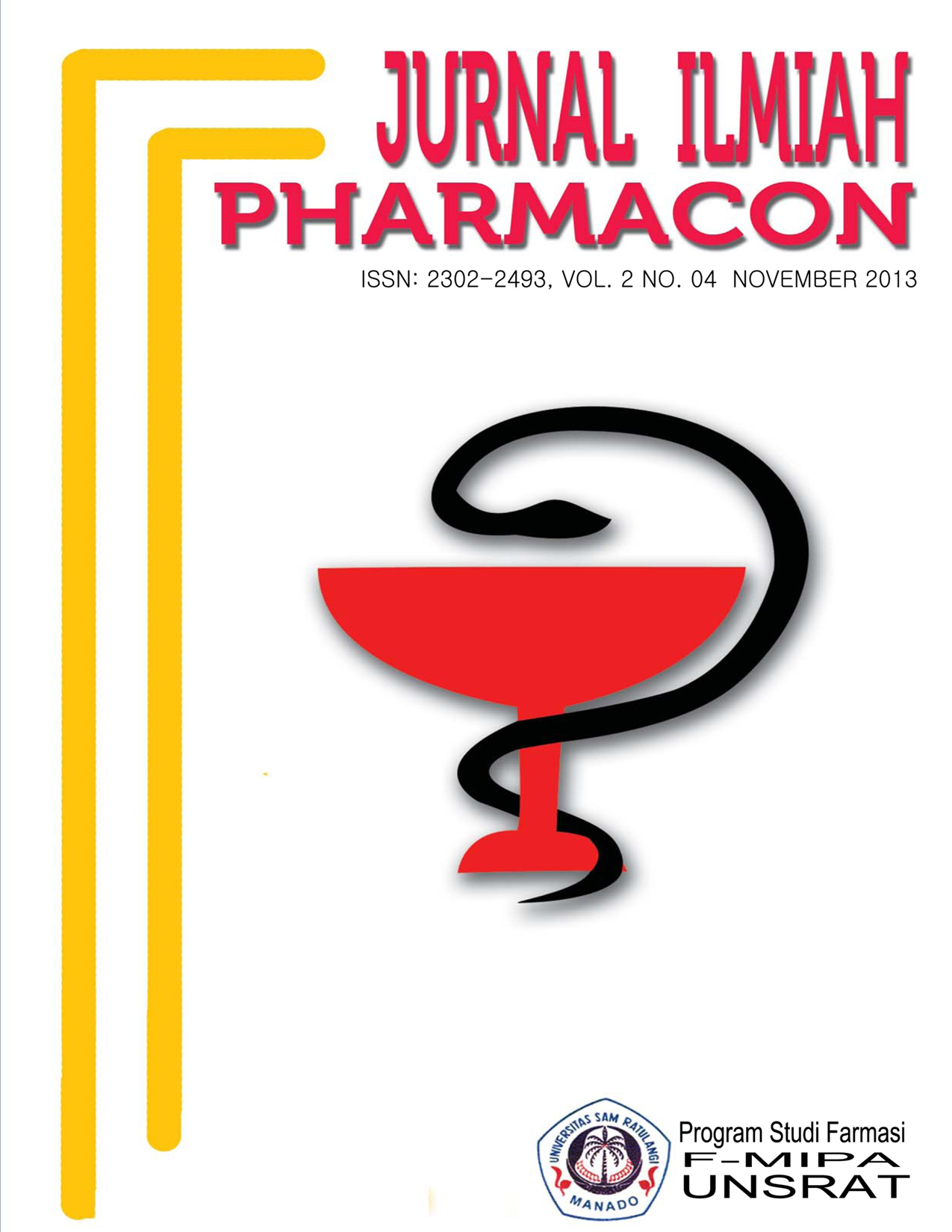FORMULASI SEDIAAN GRANUL DENGAN BAHAN PENGIKAT PATI KULIT PISANG GOROHO (Musa acuminafe L.) DAN PENGARUHNYA PADA SIFAR FISIK GRANUL
DOI:
https://doi.org/10.35799/pha.7.2018.21416Abstract
FORMULASI SEDIAAN GRANUL DENGAN BAHAN PENGIKAT PATI KULIT PISANG GOROHO (Musa acuminafe L.) DAN PENGARUHNYA PADA SIFAR FISIK GRANUL
Victoria Elisabeth1), Paulina V. Y. YamLean1), Hamidah Sri Supriati2)
1)Program Studi Farmasi FMIPA UNSRAT Manado, 95115
2)STIKES Muhamadiyah Manado, 95115
ABSTRACT
Banana plants are known for their high content of starch. In the granular formulation, starch has been widely used as fillers, binder, as well as disintegrant. The objective of this study is to formulate granule with Goroho Banana peels starch as binder material and its effect on the physical properties of the granules, which are made in five formulations with the variation of 6% for formulation I, 7% for formulation II, 8% for formulation III, 9% for formulation 4, and 10% for formulation V. In formulation I, 6.22 seconds of flow time was obtained, angle of repose 300, moisture content 20,96%, and bulk density 0,47 g/mL. In formulation II, 5.66 seconds flow time was obtained, angle of repose 290, moisture content 18,79%, and bulk density 0.45 g/mL. In formulation III, 5.50 seconds flow time was obtained, angle of repose 270, moisture content 25,49%, and bulk density 0.44 g/mL. In formulation IV 5.38 seconds flow time was obtained, angle of repose 260, moisture content 19,92%, and bulk density 0.43 g/mL. In formulation V, 6.18 seconds flow time was obtained, angle of repose 260, moisture content 21,15%, and bulk density 0.42g/mL. Banana Goroho starch can be used to formulate granule and have fit the requirement criteria for organoleptic, flow time, angle of repose evaluation, but did not fit the moisture content evaluation criteria.
Keywords: Goroho Banana (Musa acuminafe L.), starch, granules
ABSTRAK
Tumbuhan Pisang dikenal akan kandungan patinya yang tinggi. Dalam formulasi sediaan granul, pati telah digunakan secara luas sebagai bahan pengisi, bahan pengikat, maupun sebagai bahan penghancur. Penelitian ini bertujuan untuk memformulasikan sediaan granul dengan bahan pengikat pati dari kulit Pisang Goroho dan pengaruhnya terhadap sifat fisik granul yang dibuat dalam lima formulasi dengan variasi konsentrasi bahan pengikat 6% untuk formulasi I, 7% untuk formulasi II, 8% untuk formulasi III, 9% untuk formulasi IV dan 10% untuk formulasi V. Pada formulasi I didapatkan hasil pengujian waktu alir 6,22 detik, sudut diam 300, kandungan lembab 20,96%, dan bulk density 0,47 g/mL. Pada formulasi II didapatkan hasil pengujian waktu alir 5,66 detik, sudut diam 290, kandungan lembab 18,79%, dan bulk density 0,45 g/mL. Pada formulasi III didapatkan hasil pengujian waktu alir 5,50 detik, sudut diam 270, kandungan lembab 25,49%, dan bulk density 0,44 g/mL. Pada formulasi IV didapatkan hasil pengujian waktu alir 5,38 detik, sudut diam 260, kandungan lembab 19,92%, dan bulk density 0,43 g/mL. Pada formulasi V didapatkan hasil pengujian waktu alir 6,18 detik, sudut diam 260, kandungan lembab 21,15%, dan bulk density 0,42g/mL. Sediaan granul dapat diformulasikan dengan pati kulit Pisang Goroho dan memenuhi syarat uji organoleptik, uji waktu alir, uji sudut diam namun tidak memenuhi syarat uji kandungan lembab.
Kata kunci: Pisang Goroho (Musa acuminafe L.), pati, granul
Downloads
Published
How to Cite
Issue
Section
License
Authors who publish with this journal agree to the following terms:
- Authors retain copyright and grant the journal right of first publication with the work simultaneously licensed under a Creative Commons Attribution-NonCommercial 4.0 International License that allows others to share the work with an acknowledgement of the work's authorship and initial publication in this journal.
- Authors are permitted and encouraged to post their work online (e.g., in institutional repositories or on their website) prior to and during the submission process, as it can lead to productive exchanges, as well as earlier and greater citation of published work (See The Effect of Open Access)










